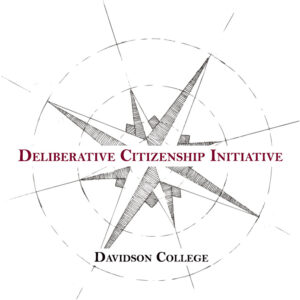
By Erik A. Anderson (Chair and Associate Professor of Philosophy, Furman University, DeeP Collaborative Member)
The Deliberative Pedagogy (DeeP) Faculty Collaborative consists of 20+ faculty from Davidson College and five other Associated Colleges of the South institutions who are committed to learning and implementing new ways to improve and deepen the quality of their class discussions. These faculty come from a wide array of disciplines and backgrounds. They come together to study and discuss different deliberative pedagogy methods, share their ideas and questions with one another, and work to embed deliberation in their classrooms. In this special blog series, members of the Collaborative describe and reflect on their experiences developing and teaching their deliberation-involved courses.
This semester at Furman University, I incorporated deliberative pedagogy into my ethics course. We hear much about how polarized Americans are about moral issues, and there is a widespread impression that Gen Z students are too busy “cancelling” each other to discuss controversial questions. I wanted to investigate to what extent these assumptions were true of my students. I also wanted to do what I could to open them up to having difficult conversations and to help them develop the skills they need to do so effectively.
My course was organized around contemporary moral issues. We covered five broad topics: freedom of speech, animal rights, racism and sexism, environmental ethics, and abortion. My plan was to hold “deliberation days” on each of these topics in which students would reason together about competing policies. The students were told that on these days, we would pretend the class was a legislature and that our job was to debate and then vote on which policies to adopt. I described deliberative pedagogy on the syllabus as aiming “to improve our abilities as citizens to engage in democratic deliberation about pressing moral and political issues. […] The specific aim of the course in relation to deliberation is that you develop the ability to engage in respectful discussion with others who disagree with you about moral questions that matter deeply to you.” In order to introduce deliberation to the students, I assigned readings by Amy Gutmann and Dennis Thompson, Diana Hess and Paula McAvoy, and Scott Aikin and Robert Talisse. However, students primarily learned about deliberation by doing it.
Before the first deliberation day, I created “ten commandments,” in consultation with the class, that would govern our deliberations:
(i) Judge ideas, not people.
(ii) Be honest and respectful.
(iii) Vegas rules: don’t post criticisms of your fellow students on social media.
(iv) Commit to empathetic listening. Don’t listen just to find weaknesses in opposing views.
(v) Try to understand competing perspectives and be fair to them.
(vi) Disagree with curiosity, not hostility.
(vii) Give other students the benefit of the doubt.
(viii) Be brief so that everyone has the chance to participate.
(ix) Monitor your body language: avoid eye rolls and other expressions of disdain.
(x) Seek consensus, not victory.
In commenting on and explaining these rules, I connected them with some of the “deliberative virtues” developed in the literature as well as with the “deliberative dispositions” promoted by the Deliberative Citizenship Initiative. While it was largely up to the students to enforce the rules, there were, to my knowledge, no incidents in which students violated them.
I faced some practical challenges in organizing the deliberation days. Foremost among them was the lack of time (the class was only 50 minutes long) and the large size of the group (25 students). To make sure each student got to participate, I divided the class into groups of three and four students. I assigned students to the groups randomly and varied their membership each time in order to prevent students from only deliberating with friends or people they were likely to agree with. I also had the deliberation proceed through distinct stages. For each topic, I focused our attention on two competing policy proposals. In the first stage, students were instructed to present to their small group what they took to be the strongest arguments and the most serious objections to each of the competing proposals. The point was for students to articulate arguments for and against different policies without yet defending a position of their own. I hoped this would encourage them to be even-handed. Only after they laid out considerations for and against each proposal did I ask them, in the second stage, to state what position they supported and why. At this stage, they engaged in deliberation proper. They sought to persuade the members of their small group that their favored proposal was the better one. I circulated around the room so I could get a sense of how things were going, but I remained hands-off because I didn’t want to inhibit or influence their conversations.
After about 25 minutes in their small groups, we moved to a third stage in which each small group reported to the whole class about how their deliberations had gone. Was there any consensus about the best proposal? Was one of the proposals more widely accepted than the other? What were the reasons for and against each proposal articulated in the deliberation? Then, in a fourth stage, I posed the question again for the whole class to consider: which of the two proposals should we, as a class, adopt? My thinking was that individuals who offered arguments addressed to the whole class would have had their understanding of the issue and their arguments refined through their small group deliberations. In the whole group deliberation, students explained why they found the arguments favoring one of the proposals to be more compelling than those supporting the alternative. When one person defended a particular view, I would ask for rebuttals from the other side. While it was very tempting for me give my own input, I tried to stay in a facilitative role and to leave the deliberation up to the students themselves.
In a final stage, after about 15 minutes of whole-group deliberation, we took a vote. Students voted anonymously on Zoom, which instantly tallied the results. As the vote happened right at the end of our 50-minute class, I had to wait for the following class to debrief the exercise. Students had to write a “deliberation report” in which they summarized the arguments for and against the two proposals, defended their own view, reflected on the process of deliberation (for example, I asked them whether at any point they had changed their minds), and had the opportunity to devise their own alternative proposals.
One thing I didn’t anticipate was how difficult it was to come up with proposals for the students to discuss that were clearly distinct and yet both had initial plausibility. On free speech, for example, I decided to focus on the limits on what kinds of controversial materials professors could teach in class. There was consensus that professors and students shouldn’t use hate speech (e.g. slurs, verbal attacks) and that it was permissible for professors to assign materials that contained examples of hate speech as long as there were legitimate academic reasons for doing so. But students disagreed about material containing academic arguments in support of (what they took to be) racist, sexist, homophobic, or transphobic conclusions. I wanted the class to deliberate about a proposal that was relatively permissive — giving professors more leeway to assign controversial materials — and one that was more restrictive. But the more plausible I tried to make the two proposals, the more qualified and nuanced they became, the more they started to blur into one another. On the other hand, the more distinct I tried to make them, the more “extreme” they became, which threatened to make them nonstarters for the students. The proposals I ended up with were somewhat vague and ambiguous, saying things like “professors may assign materials that present sexist, racist, or other objectionable ideas as long as doing so serves a legitimate academic purpose” and “professors should not assign materials that marginalize, exclude, or denigrate students on the basis of their race, sex, gender identity, etc.” Students interpreted a number of the key phrases in these proposals differently, which meant that they weren’t always assigning the same meanings to the competing alternatives.
Despite this (unresolved) problem, students reported that they enjoyed the activity of deliberation and found it useful. There were no heated conflicts and it didn’t seem to me that students felt the need to censor themselves (though it’s hard to know for sure — in hindsight, I should have asked them about self-censorship on their deliberation reports). I do have to mention one caveat, however. The whole semester we were building toward a deliberation day on the most controversial issue by far, abortion. Unfortunately, I came down with COVID after spring break and had to cancel a number of classes. As a result, we were not able to have a final deliberation on abortion. That issue would have been an important test case for how proficient the students had become at deliberation. I can say, though, that the discussions we had on the readings about abortion were civil and productive even when we discussed pro-life views, which conflicted with the views held by most students. One student who said early in the semester that “men are not entitled to have an opinion about abortion” had by the end of the term come around to seeing the importance of listening to diverse perspectives on the issue.
As a first-time experiment, my attempt to teach ethics deliberatively wasn’t entirely successful, but it was successful enough to be worth working on and improving in the future. I was especially impressed by how seriously the students took our deliberation days — as if the members of Gen Z were hungry for the kinds of respectful moral and political conversations that are so lacking in America today.
